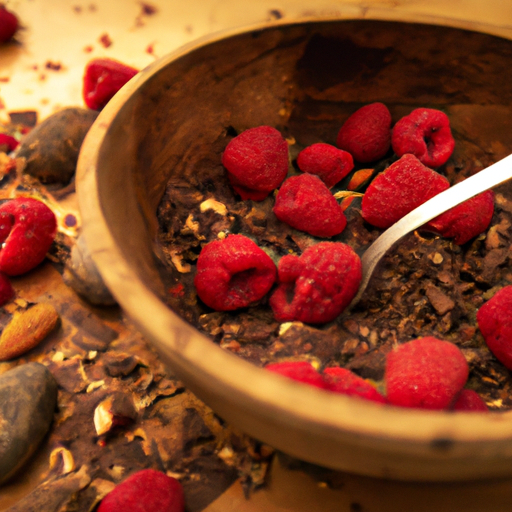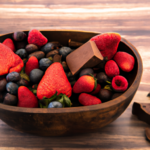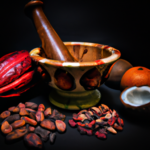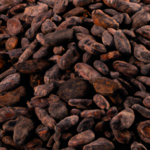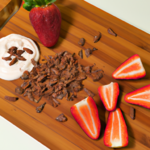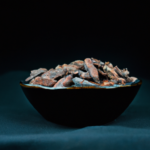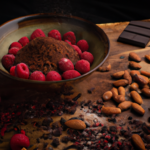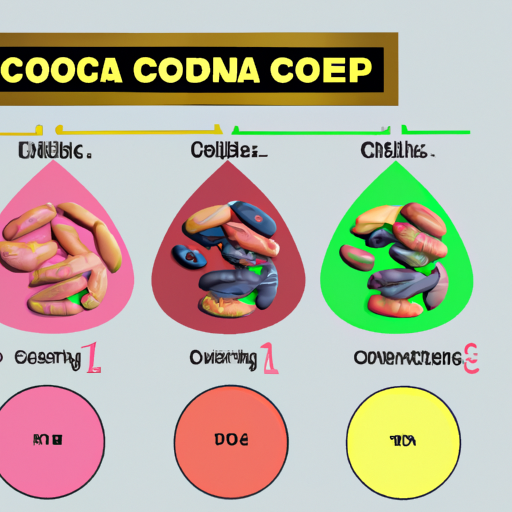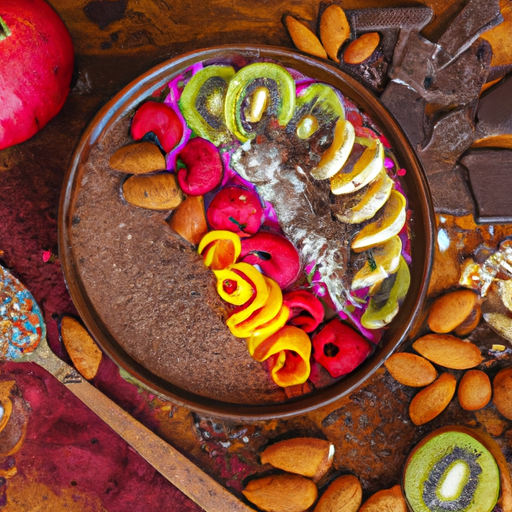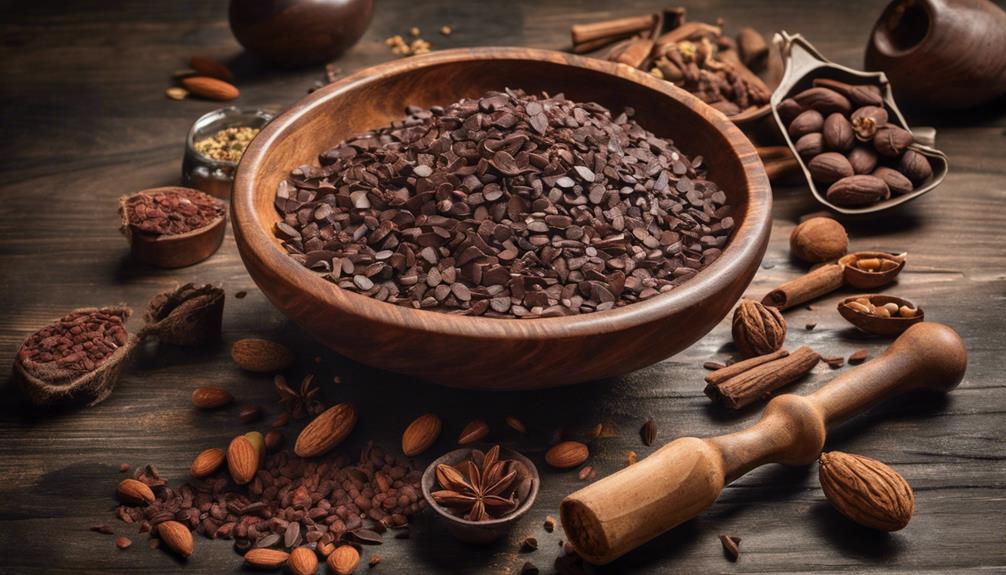Did you ever imagine that raw cacao nibs could make such a significant impact in the realm of healthy eating? The idea of chocolate being beneficial for your health is certainly intriguing. I’m excited to share with you some useful and tasty ways to incorporate these nutrient-packed nibs into your everyday diet.
Whether you’re looking to add a boost of antioxidants to your morning smoothie or create a decadent homemade chocolate treat, raw cacao nibs have got you covered.
Sprinkle them on top of yogurt or oatmeal for a crunchy and satisfying texture, or blend them into nut butters for a rich and indulgent flavor.
You can even infuse them in milk or cream for a luxurious hot chocolate experience.
So, if you’re ready to take your snacking game to the next level, join me as we explore the wonderful world of raw cacao nibs and discover just how versatile and delicious they can be. Get ready to indulge in guilt-free chocolate bliss!
Key Takeaways
- Cacao nibs can be enjoyed on their own or incorporated into recipes.
- They can be added to smoothie bowls for added crunch and nutrition.
- Cacao nibs can be mixed into granola or trail mix.
- They can be used in baked goods for a nutrient-rich twist.
Add Them to Smoothies and Shakes
Add cacao nibs to your smoothies and shakes for a rich and indulgent boost of chocolatey goodness! These small, crunchy bits of raw cacao are packed with antioxidants and essential nutrients.
Simply blend a handful of cacao nibs with your favorite smoothie ingredients like bananas, almond milk, and spinach for a deliciously nutritious treat.
If you’re a coffee or tea lover, try adding cacao nibs to your morning brew for a hint of chocolate flavor.
You can also incorporate them into your baking recipes by mixing them into brownie batter or sprinkling them on top of cookies before baking. The possibilities are endless!
Now, let’s move on to the next section and discover how to sprinkle them on top of yogurt or oatmeal.
Sprinkle Them on Top of Yogurt or Oatmeal
Sprinkle these crunchy nuggets of goodness atop your morning yogurt or oatmeal. This will ensure a delightful texture and a burst of rich flavor. Adding cacao nibs to your breakfast not only enhances the taste but also provides numerous benefits. These small but mighty nibs are packed with antioxidants, fiber, and essential minerals like magnesium and iron. They can help boost your energy levels, support cardiovascular health, and even improve your mood.
Incorporating cacao nibs into your daily meals is easy and versatile. Besides yogurt and oatmeal, you can also add them to smoothies, pancakes, or even sprinkle them on top of your favorite granola. The options are endless! So go ahead, give your breakfast a nutritious and delicious upgrade.
Next, let’s explore how you can use cacao nibs as a topping for desserts or baked goods.
Use Them as a Topping for Desserts or Baked Goods
Enhance your desserts and baked goods with the irresistible crunch and rich flavor of cacao nibs, taking your treats to a whole new level of deliciousness. Not only do cacao nibs add a delightful texture, but they also provide a range of health benefits. These small pieces of pure chocolate are packed with antioxidants, fiber, and essential minerals like iron and magnesium. To incorporate cacao nibs into your desserts and baked goods, simply sprinkle them on top of your favorite treats before baking. You can also use them as a topping for ice cream, pies, or cupcakes. For a savory twist, try adding cacao nibs to salad dressings or sprinkle them over roasted vegetables. Their versatility and unique flavor make them a perfect addition to any recipe. Now, let’s move on to the next section and discover how to mix cacao nibs into homemade energy bars or granola.
Mix Them into Homemade Energy Bars or Granola
To take your homemade energy bars or granola to the next level of deliciousness, mix cacao nibs into the batter for an irresistible crunch and rich chocolate flavor.
Raw cacao nibs are not only a delicious addition to your diet, but they also offer numerous health benefits. These little nibs are packed with antioxidants, which help protect your cells from damage caused by free radicals. Additionally, they contain essential minerals like magnesium, iron, and calcium, which are vital for maintaining a healthy body.
There are different ways to incorporate raw cacao nibs into your diet. You can sprinkle them on top of your granola or mix them into the batter for energy bars. You can also blend them into nut butters or homemade chocolate for an extra dose of chocolatey goodness.
Transitioning into the next section, blending cacao nibs into nut butters or homemade chocolate adds a creamy and indulgent twist to your treats.
Blend Them into Nut Butters or Homemade Chocolate
Mixing cacao nibs into your favorite nut butter or homemade chocolate will take your taste buds on a wild and sinfully delicious ride. The blending possibilities are endless when it comes to incorporating these crunchy little bites of goodness into your homemade treats. Not only do cacao nibs add a rich and intense chocolate flavor, but they also provide numerous health benefits.
-
The combination of cacao nibs and nut butter creates a creamy and indulgent spread that satisfies your sweet tooth while delivering a dose of antioxidants and essential minerals.
-
Blending cacao nibs into homemade chocolate allows you to control the sweetness and intensity of the chocolate, resulting in a healthier version of your favorite treat.
-
Adding cacao nibs to your chocolate chip cookie recipe adds a delightful crunch and boosts the antioxidant content of your baked goods.
With so many ways to enjoy cacao nibs, it’s easy to incorporate them into your daily routine. Now, let’s explore how to create a healthy trail mix with nuts and dried fruit.
Create a Healthy Trail Mix with Nuts and Dried Fruit
One delicious way to incorporate the goodness of nuts and dried fruit into your diet is by creating a healthy trail mix. Not only is it a convenient and portable snack, but it also offers numerous benefits for your health. A well-balanced trail mix provides a good source of protein, fiber, healthy fats, and essential vitamins and minerals. The combination of nuts and dried fruit offers a satisfying crunch and a burst of natural sweetness. To give you an idea of the nutritional value, here’s a table showcasing the benefits of some common nuts and dried fruits:
| Nut/Dried Fruit | Benefits |
|---|---|
| Almonds | High in vitamin E and magnesium |
| Walnuts | Rich in omega-3 fatty acids |
| Cashews | Good source of zinc and iron |
| Raisins | High in antioxidants |
By including a variety of nuts and dried fruit in your trail mix, you can enjoy a balanced and nutritious snack that satisfies your cravings and provides essential nutrients. Now, let’s move on to making a delicious hot chocolate with raw cacao nibs.
Make a Delicious Hot Chocolate with Raw Cacao Nibs
Indulge in a warm and comforting cup of hot chocolate made with the rich and decadent flavor of raw cacao nibs. These nibs can help boost your mood with their natural antidepressant properties.
Raw cacao nibs are a versatile ingredient that adds depth and complexity to your hot chocolate. To create a unique and delicious hot chocolate, start by grinding the cacao nibs into a fine powder. Then, mix the powder with hot water or milk and sweeten to taste with your preferred sweetener.
The health benefits of raw cacao nibs in hot chocolate are numerous. They are packed with antioxidants, which can help reduce inflammation and support heart health. Additionally, raw cacao nibs contain minerals like magnesium and iron that are essential for maintaining a healthy body.
Infuse them in milk or cream for a rich flavor that will elevate your hot chocolate experience.
Infuse Them in Milk or Cream for a Rich Flavor
For a truly indulgent and velvety hot chocolate experience, infuse your milk or cream with the rich and decadent flavor of these magical cacao nibs. Here are five ways to enjoy this delightful infusion:
- Stir the infused milk or cream into your morning coffee for a unique and delicious flavor enhancement.
- Experiment with incorporating cacao nibs into savory dishes like chili or mole sauce for a surprising twist.
- Use the infused milk or cream in recipes for desserts like custards or ice creams, adding a depth of flavor that will impress your guests.
- Drizzle the infused liquid over fresh fruit or yogurt for a healthy and satisfying treat.
- Blend the infused milk or cream with frozen bananas and a dash of honey for a luscious cacao nib smoothie.
By infusing your milk or cream with cacao nibs, you’ll unlock a world of possibilities beyond just hot chocolate.
Now, let’s explore how to enjoy them as a snack on their own for a nutrient boost.
Enjoy Them as a Snack on Their Own for a Nutrient Boost
To fully appreciate the nutritional benefits, try enjoying these cacao nibs as a standalone snack. Raw cacao nibs are packed with nutrients that can support your overall health. They are an excellent source of antioxidants, which can help protect your cells from damage caused by free radicals. Additionally, cacao nibs are rich in fiber, which can promote healthy digestion and help you feel full for longer periods of time.
Here is a table showcasing the nutritional benefits of raw cacao nibs:
| Nutrient | Amount per 1 oz (28g) |
|---|---|
| Fiber | 9 grams |
| Iron | 6% of the daily value |
| Magnesium | 16% of the daily value |
| Zinc | 6% of the daily value |
| Flavanols | High content |
Apart from enjoying them on their own, you can also get creative with recipes using raw cacao nibs. They can be sprinkled on top of smoothie bowls, added to granola or trail mix, or even incorporated into baked goods for a delicious and nutrient-rich twist. So go ahead, grab a handful of cacao nibs and savor the health benefits they offer!
Frequently Asked Questions
Are raw cacao nibs safe to consume?
Raw cacao nibs are safe to consume, but they may have potential side effects like increased heart rate and digestive issues. It is recommended to consume no more than 1-2 tablespoons per day for optimal health.
Can raw cacao nibs be used in savory dishes?
Raw cacao nibs can add a delightful twist to savory dishes. Sprinkle them on salads for a crunchy, chocolatey punch or blend them into savory sauces for a rich, complex flavor. Get creative and explore the savory side of cacao!
How do raw cacao nibs compare to other forms of chocolate in terms of health benefits?
Raw cacao nibs are packed with antioxidants, fiber, and minerals, making them a healthier option compared to most forms of chocolate. They may even serve as a natural remedy for certain health conditions.
Can raw cacao nibs be used as a substitute for cocoa powder in recipes?
Raw cacao nibs can be used as a substitute for cocoa powder in recipes. They offer more health benefits compared to cocoa powder because they are less processed and retain more nutrients and antioxidants.
How should raw cacao nibs be stored to maintain their freshness?
To maintain the freshness of raw cacao nibs, store them in an airtight container in a cool, dark place. Avoid exposure to heat, light, and moisture, as these can cause the nibs to go bad.
Do the methods of preparation affect the consumption of raw cacao nibs?
The methods of preparing organic cacao nibs can greatly affect their consumption. Roasting the nibs can enhance their flavor and make them more palatable for some people. However, consuming them raw maintains their nutritional benefits. The method of preparation can ultimately impact how people choose to enjoy these nutritious nibs.
Conclusion
To conclude, consuming raw cacao nibs is a delicious and nutritious way to add a boost of flavor and health benefits to your diet.
Not only can you enjoy them on their own as a snack, but you can also incorporate them into a variety of recipes and dishes.
Did you know that raw cacao nibs are packed with antioxidants? In fact, they contain even more antioxidants than blueberries and goji berries!
So go ahead and indulge in the goodness of raw cacao nibs, and elevate your culinary creations to new heights of taste and wellness.

